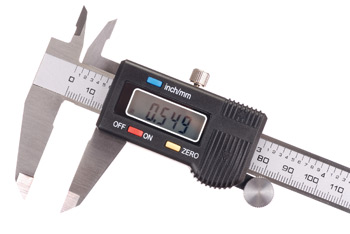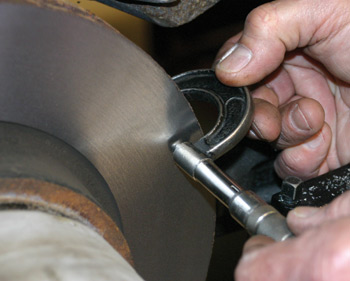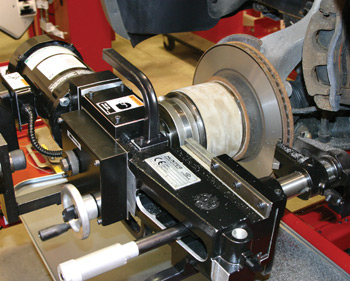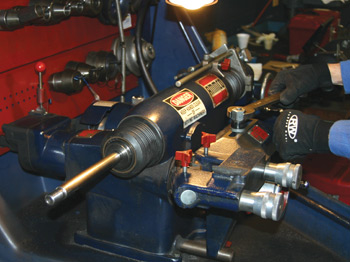It’s funny how opposite things in life end up working together so many times! How many times have you seen couples that look different, act different, have different tastes, and yet manage to have great relationships? How about medicines? Many immunizations are actually small amounts of the disease virus they prevent! Weird, huh?

Brake repair and service is another example of things that seem opposite, but are working to help one another. Brake repair makes sure your customers’ cars stop, and brake repair can make your business go!
The trick to serving your customers’ needs for brake repair depends on you having the right training, the right parts and the right tools. This article will focus on the last issue. You are on your own for the first two!
Brake service tools fit into several different categories. There are: adjustment tools; bleeding/hydraulic tools; specialty tools; diagnostic/electronic tools; general assembly tools; cleaning/containment equipment; and refinishing tools.
I will talk a little bit about the tools in the order that you might need them.
Inspection and Protection
As a technician, you most likely see the following repair order every day: Customer Complaint: “brake noise, check and advise.” After taking the car for a test drive, you bring it into the bay to start your inspection process. Right away you are going to need tools to do the job. The first step to do a brake inspection involves removing the wheel/tires so you can get a good look at the brake system. If you do a lot of wheel/brake work, you are going to want to invest in a good 1/2” impact wrench. Look for a model that has a high torque rating (500+ ft.-lbs.) and make sure that the torque rating works in both forward and reverse! One of the toughest things about brake work can be rusty lug nuts and bolts. Road salt and grime can make removal especially difficult.

Today’s wheels can be extremely expensive; both OEM and aftermarket wheels can run into the thousands of dollars. Just one scratch on a wheel like that can erase every bit of profit you would make on the brake job (and probably all the jobs that day). One way to avoid wheel damage is to invest in specialty nylon-coated wheel nut sockets. These sockets are designed for use on alloy and aluminum wheels. The outside of the sockets has a sleeve made of nylon. This sleeve reduces the possibility of scratching the wheel and lug nuts. Another critical item to add to your box is a good wheel nut/lock kit. These kits are worth their weight in gold. Designed to remove damaged or rounded lug nuts, they are one of those tools that can “save your bacon.” These kits also include many of the keys required to remove wheel nut locks used on OEM and aftermarket wheels and wheel covers.
Once you have the wheels off, the real fun begins. Depending on the type of vehicle and system you are working on, you are going to need some specific tools to continue the inspection process. Good lighting is critical for making the right diagnosis. Due to the location of the brakes (inside the fender wells), light is a challenge. There are lots of great options today for lighting — LED, incandescent, fluorescent, corded, cordless, rechargeable, reel and hand held. LED lighting has become a dominant force in shop lighting. These lights feature cool operating temperatures, bright light, low power consumption and extremely long life. Whether you choose a hand-held rechargeable flashlight-style light, or a more traditional angle-style light on a reel, you can’t go wrong with LED lighting.

You are going to need a good set of measurement equipment to diagnose brakes. A digital caliper designed for measuring brake rotors is a must. Once a tool that was prohibitively expensive, there are now many good lower cost solutions available. This allows you to quickly determine if a rotor is within allowable specs or should be replaced. While there are fewer and fewer cars on the road today with drum brakes, many light-duty trucks still have rear drum brakes. You also will need to consider investing in a brake drum micrometer. To round out the measuring equipment, you might consider a brake shoe/pad measurement device. This inexpensive tool lets you quickly and accurately check pad and shoe thickness.
For unusual or difficult diagnosis, it is nice to be able to check brake system pad pressure. This is the actual amount of force being applied to the rotors by the brake pads. This tool includes load cells connected via a hose to a gauge. The gauge reads in thousands of pounds per square inch. By comparing readings from wheel to wheel, you can determine if a certain caliper is not functioning properly.
Disc brakes as well as drum brakes need some specific tools to allow you to disassemble and repair them. Your caliper tools should include an assorted set of both hex bit sockets as well as Torx-style sockets. In addition, you will want to invest in a heavy-duty brake pad spreader (used to push back the caliper pistons) and an assortment of caliper piston turnback tools (for self-adjusting parking brake caliper pistons). You will need good heavy-duty flare nut wrenches for removing and installing brake lines. And you will need brake bleeder wrenches. These special-shaped box end wrenches allow you to access the bleeder valves for bleeding operations.
Drum brakes will need some specific tools added to the box. A large assortment of brake shoe adjusting tools or “spoons” is a must have. In addition, you will need brake spring tools for the removal and installation of hold down and return springs. Finally, you may also want to invest in an emergency or parking brake spring tool. This tool can be a big help when reinstalling drum-style brakes.
While there are many more general tools for the disassembly and repair of brakes, the above will be a good start for you.
ABS Scan Tools
Electronic diagnosis has become a bigger part of repairing today’s brake systems. With the advent of ABS/Stability control and other computer-aided systems, it is becoming almost mandatory to have a scan tool to diagnose and repair brake problems. Many of today’s vehicles are using brake systems that are actuated and controlled by servo motors or solenoid-type devices. Even if there is no electronic fault with the system, you cannot service or repair these vehicles without some “magic box” technology. In order to change brake pads on many late-model European vehicles, you must “tell” the car’s on board computer(s) what you are doing before you can remove or repair the disc brakes. Failing to use the right equipment when servicing these systems can result in hundreds of dollars in damage and possible injury to the technician. The good news is there are several reasonably priced devices now available to communicate and deactivate the brake systems on these cars. These tools are also needed to teach the car’s computer how thick the new brake pads are so it can do its job the way it was designed.
Determining faults also involves being able to read and interpret system fault codes. This can be accomplished by using either a stand-alone ABS code reader or as an add-on to your diagnostic scan tool. The stand-alone units are functional and do a good job of giving you brake-related fault codes. This can be a lower cost solution for shops that don’t service many brake systems or later model vehicles. If your shop is a full-service shop offering driveability services, you are going to want to invest in a full scan tool with ABS brakes as a part of the total package.
Keep It Clean
Another area of discussion regarding brake tools and equipment is cleaning and containment. These tools are a good idea for everyone and in some parts of the country are mandatory for technician safety. Designed to contain and diminish airborne dust and contaminants when servicing brakes, this equipment allows the technician to “wash” the brake system before disassembly. It also serves to capture any fluid or spills that might occur during repair, eliminating the possibility of ground water contamination. These range from a basic catch-style basin to more sophisticated systems incorporating containment “hoods or bags” designed to actually surround the wheel/brake assembly during the washing process. The cleaning system makes sense on several fronts. It is easier and faster to work on the brakes if they are free of excess grime, dust and/or grease. The tech is less likely to get respiratory illnesses from breathing airborne dust. The dirty and contaminated fluids don’t end up in the water supply. That’s a pretty good solution for everyone!
Refinishing
One final area of equipment to discuss is refinishing equipment. While the cost of rotors and drums has dropped dramatically, there are still many times when refinishing or “turning” drums and rotors still makes sense. If your shop does a lot of brake service, this can become a profit center both for you and also for neighboring shops. The ability to turn a drum or rotor frees you up from waiting for either a parts delivery or a machine shop to resurface them.

Like many of the other tools and equipment I have already discussed, there are choices on what type and quality refinishing equipment you purchase. For many late-model vehicles, the removal of the rotors can be difficult and time consuming. These vehicles are good candidates for on-the-vehicle-style brake lathes. This style of brake lathe bolts onto the car or truck and refinishes the rotor while it is in place. These units even can provide their own alternate “power” to rotate the rotor assembly for refinishing. This allows the turning of rotors on non-drive axles and eliminates the need to run the vehicle in the shop, eliminating noise, fumes and risk of injury to technicians and damage to the vehicle.

A more traditional approach is the conventional bench-style lathe. Bench-style lathes can be more expensive than the on-the-vehicle style, but have some advantages to consider. Many times bench lathes will be able to machine both drums and rotors. Also, the bench lathes are usually able to accommodate larger drums and rotors than on-the-vehicle-style lathes. The choice for your shop will come down to cost of equipment versus number of brake jobs done per day/week/year. Whichever choice you make, owning a brake lathe is a great way to build productivity, profit and efficiency in your business.
So we have talked about a lot of different tools and equipment here. Many of these tools are “nice to haves” and some of them are “must haves.” Over time you will find items moving from the nice-to-have column to the must-have column. Many times there is a way to fix a vehicle without a special tool or piece of equipment, but that takes time, and time is money. So the next time you are going to “fake it” with the wrong brake service tool, keep track of how long it takes for your solution.
Providing your customer with quality brake service at fair pricing is good for you and your customer. It helps them Stop their vehicle, and Stop worrying about dependability/safety. It helps you Start improving your earnings, Start selling more service, and most importantly, Start the buck$ flowing back into your business again!




